Among the many leafminers that affect ornamental and vegetable plants are:
American serpentine leafminer, Liriomyza trifolii
Beet leafminer, Pegomya betae
Birch leafminer, Fenusa pusilla
Boxwood leafminer, Monarthropalpus flavus
Columbine leafminer, Phytomyza aquilegivora and P. columbinae
Pea leafminer, Liriomyza huidobrensis
Spinach leafminer, Pegomya hyoscyami
Vegetable leafminer, Liriomyza sativae
Leafminers are the larval form of a fly in the order Diptera that cause damage to the edible foliage vegetable crops of spinach, beets, chard, other vegetables, and some ornamental trees, shrubs, and herbaceous plants. The feeding damage appears in the form of hollowed out whitish, serpentine tunneling patterns that will coalesce into larger blotchy areas in the mesophyll tissue between the upper and lower layers of the leaves. The tunneling larvae will also leave excrement behind, making vegetable leaves unfit for human consumption. Moderate damage will not affect beet root quality although severe leaf damage can result in poor root development.
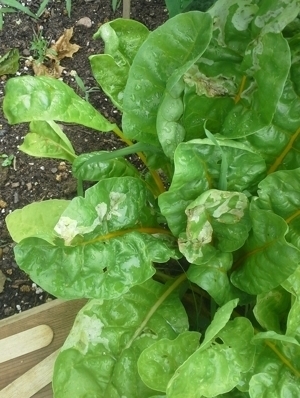
Life Cycle
The adult flies of many vegetable leafminers appear in the spring from late April through mid-May after overwintering as pupae in the soil or in plant debris. The tiny, ¼”, hairy gray adult flies mate and the female will lay tiny white eggs either singly or in clusters on the undersides of the developing leaves of the host plant. The newly hatched legless larvae will burrow into the interior of the leaves to begin feeding. When the larvae are mature they will chew through the leaf surface, drop to the ground, and pupate. The life cycle of the leafminer is 30-40 days long so there can be 3-4 overlapping generations per year. Spinach leafminer adult, eggs, feeding damage, and larvae, below, right to left.
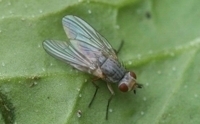
Adult spinach leafminer, Image by Whitney Cranshaw photo, Bugwood.org

Spinach leafminer eggs, Image by Jude Boucher, UConn
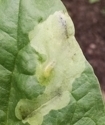
Spinach LM damage, Images by Susan Pelton, UConn
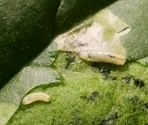
Spinach LM damage, Images by Susan Pelton, UConn
Control Measures
- The larvae drop to the soil to pupate near their host plant so rotating susceptible crops will help to limit next year’s damage.
- Crush or remove leaves that have eggs or mines/larvae and disposeof them in sealed bags.
- Bury affected leaves deeply in a compost pile.
- Use floating row covers to exclude flying adults if leafminers were a problem the previous year.
- If a spring crop was affected plant a fall crop in a different area and use row covers.
- Foliar insecticides are ineffective once the feeding larvae are protected within the leaves.
- Spinosad may be sprayed on leaf surfaces before eggs hatch so that the emerging larvae will consume it as they enter the leaves. Spinosad is a low-toxicity insecticide but it may still affect pollinators so it should be applied in the evening when pollinators are less active.
Boxwood Leafminer
The boxwood leafminer females insert their ovipositor directly into the leaf. The next two life stages happen within the leaf. The newly-hatched larvae feed within the leaf throughout the summer and remain within the leaves over the winter. In the spring the larvae pupate while still within the leaf blister. The orange adult flies emerge in May and pesticide applications need to be timed to when the adults are active.
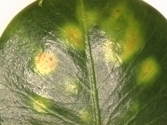
Boxwood leafminer feeding damage
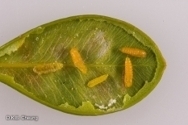
Boxwood larvae
Despite good cultural practices, pests and diseases at times may appear. Chemical control should be used only after all other methods have failed. Please follow all label instructions which supersede any recommendations in this publication. For pesticide information please call UConn Home and Garden Education Center weekdays, in Connecticut call toll free 877486-6271. Out of state call 860-486-6271. UConn Home and Garden Education Center, 2018